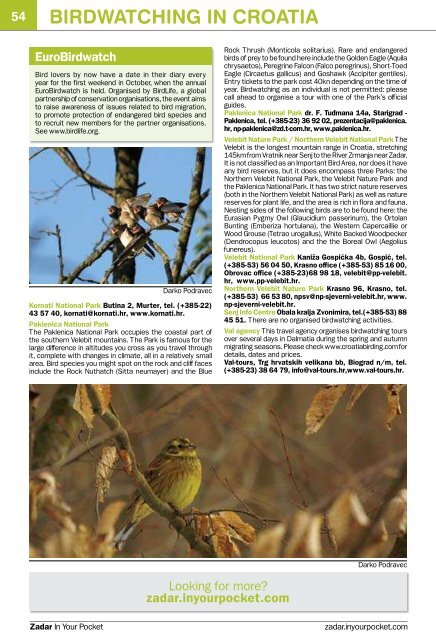Create successful ePaper yourself
Turn your PDF publications into a flip-book with our unique Google optimized e-Paper software.
54 birdwatching in croatia<br />
Fishing on the Adriatic 55<br />
EuroBirdwatch<br />
Bird lovers by now have a date in their diary every<br />
year for the first weekend in Oc<strong>to</strong>ber, when the annual<br />
EuroBirdwatch is held. Organised by BirdLife, a global<br />
partnership of conservation organisations, the event aims<br />
<strong>to</strong> raise awareness of issues related <strong>to</strong> bird migration,<br />
<strong>to</strong> promote protection of endangered bird species and<br />
<strong>to</strong> recruit new members for the partner organisations.<br />
See www.birdlife.org.<br />
Darko Podravec<br />
Kornati National Park Butina 2, Murter, tel. (+385-22)<br />
43 57 40, kornati@kornati.hr, www.kornati.hr.<br />
Paklenica National Park<br />
The Paklenica National Park occupies the coastal part of<br />
the southern Velebit mountains. The Park is famous for the<br />
large difference in altitudes you cross as you travel through<br />
it, complete with changes in climate, all in a relatively small<br />
area. Bird species you might spot on the rock and cliff faces<br />
include the Rock Nuthatch (Sitta neumayer) and the Blue<br />
Looking for more?<br />
zadar.inyourpocket.com<br />
Rock Thrush (Monticola solitarius). Rare and endangered<br />
birds of prey <strong>to</strong> be found here include the Golden Eagle (Aquila<br />
chrysae<strong>to</strong>s), Peregrine Falcon (Falco peregrinus), Short-Toed<br />
Eagle (Circaetus gallicus) and Goshawk (Accipiter gentiles).<br />
Entry tickets <strong>to</strong> the park cost 40kn depending on the time of<br />
year. Birdwatching as an individual is not permitted: please<br />
call ahead <strong>to</strong> organise a <strong>to</strong>ur with one of the Park’s official<br />
guides.<br />
Paklenica National Park dr. F. Tuđmana 14a, Starigrad -<br />
Paklenica, tel. (+385-23) 36 92 02, prezentacija@paklenica.<br />
hr, np-paklenica@zd.t-com.hr, www.paklenica.hr.<br />
Velebit Nature Park / Northern Velebit National Park The<br />
Velebit is the longest mountain range in Croatia, stretching<br />
145km from Vratnik near Senj <strong>to</strong> the River Zrmanja near Zadar.<br />
It is not classified as an Important Bird Area, nor does it have<br />
any bird reserves, but it does encompass three Parks: the<br />
Northern Velebit National Park, the Velebit Nature Park and<br />
the Paklenica National Park. It has two strict <strong>nature</strong> reserves<br />
(both in the Northern Velebit National Park) as well as <strong>nature</strong><br />
reserves for plant life, and the area is rich in flora and fauna.<br />
Nesting sides of the following birds are <strong>to</strong> be found here: the<br />
Eurasian Pygmy Owl (Glaucidium passerinum), the Or<strong>to</strong>lan<br />
Bunting (Emberiza hortulana), the Western Capercaillie or<br />
Wood Grouse (Tetrao urogallus), White <strong>Back</strong>ed Woodpecker<br />
(Dendrocopus leuco<strong>to</strong>s) and the the Boreal Owl (Aegolius<br />
funereus).<br />
Velebit National Park Kaniža Gospićka 4b, Gospić, tel.<br />
(+385-53) 56 04 50, Krasno office (+385-53) 85 16 00,<br />
Obrovac office (+385-23)68 98 18, velebit@pp-velebit.<br />
hr, www.pp-velebit.hr.<br />
Northern Velebit Nature Park Krasno 96, Krasno, tel.<br />
(+385-53) 66 53 80, npsv@np-sjeverni-velebit.hr, www.<br />
np-sjeverni-velebit.hr.<br />
Senj Info Centre Obala kralja Zvonimira, tel.(+385-53) 88<br />
45 51. There are no organised birdwatching activities.<br />
Val agency This travel agency organises birdwatching <strong>to</strong>urs<br />
over several days in Dalmatia during the spring and autumn<br />
migrating seasons. Please check www.croatiabirding.com for<br />
details, dates and prices.<br />
Val-<strong>to</strong>urs, Trg hrvatskih velikana bb, Biograd n/m, tel.<br />
(+385-23) 38 64 79, info@val-<strong>to</strong>urs.hr,www.val-<strong>to</strong>urs.hr.<br />
Darko Podravec<br />
Nedo Buljan<br />
“The gods do not subtract from the allotted span of men’s<br />
lives the hours spent on fishing.” - Assyrian proverb<br />
The Croatian Adriatic is among cleanest seas in Europe. Add<br />
<strong>to</strong> that its warmth, shallowness, and lack of strong tides and<br />
currents, and you have an ideal environment for the joys of<br />
recreational fishing.<br />
Croatia is often called “the country of a thousand islands”<br />
due <strong>to</strong> its 66 islands, 652 islets, 389 rocks and 78 reefs.<br />
The waters of the Adriatic are rich in fish, aquatic mammals,<br />
seaweed, plank<strong>to</strong>n, shellfish, crabs and sponges. It’s no<br />
wonder that the tradition of fishing here goes back millennia.<br />
Apart from being a vital industry and a traditional way of life,<br />
fishing <strong>to</strong>day for many people provides an ideal way <strong>to</strong> relax<br />
and reconnect with <strong>nature</strong>.<br />
Fishing techniques tend <strong>to</strong> be passed down through<br />
generations, and you’ll often see grandparents and<br />
grandchildren heading out happily <strong>to</strong>gether <strong>to</strong> catch fish.<br />
The locals, of course, know the best tips and tricks for<br />
their particular waters, and will usually be glad <strong>to</strong> help and<br />
advise you.<br />
Keen anglers will find all kinds of fishing opportunities in<br />
Croatia due <strong>to</strong> the diversity of the coastal terrain. Just some<br />
of the places you might like <strong>to</strong> explore include: the islands<br />
of Mali Lošinj, Jabuka, Svetac and Mali Ždrelac; the channel<br />
that connects the Zadar and the Central channels; and the<br />
Bay of Pag, where there are so many fish that you can exceed<br />
your legal fishing limit with alarming ease. Then there’s the Tri<br />
Sestrice islets near Zadar and the entire Zadar archipelago.<br />
Lovers of spearfishing will find their nirvana in the mystical<br />
depths around the islands of Glavat and Molunat. You can<br />
also have unique fishing experiences off the coast of the<br />
Pelješac peninsula and close <strong>to</strong> the island of Šolta, a spot<br />
so beloved of Roman emperor Diocletian that he ordered<br />
fish ponds be built on the island. You might be lucky enough<br />
<strong>to</strong> spot a Mediterranean monk seal, one of the world’s most<br />
endangered species, which is often spotted around Šolta.<br />
There are over 400 species of fish native <strong>to</strong> the Adriatic, and<br />
if you’re hunting for your lunch or dinner in a local restaurant<br />
you’ll most likely “catch” orada (sea bass), brancin (sea<br />
bream), arbun (common pandora), skuša (mackerel),<br />
lokarda (chub mackerel), srdele (sardines), papaline<br />
(sprats), škarpina (scorpion fish), trlja (red mullet), ušata<br />
(saddled seabream), pic (sharpsnout seabream), zubatac<br />
(dentex), grdobina (monkfish), and kovač (John Dory).<br />
However, because of various threats presented by mankind<br />
such as pollution, overfishing and increasingly intensive<br />
<strong>to</strong>urism, more and more species native <strong>to</strong> the Adriatic are<br />
endangered. The following species have protected status<br />
in Croatia: the ocean sunfish (lat. Mola mola), fan mussel<br />
(Pinna nobilis), date mussel (Lithophaga lithophaga), Caspian<br />
gull (Larus cachinnans), green wrasse (Labrus viridis),<br />
sea cucumber (Holothurioidea), Mediterranean monkseal<br />
(Monachus monachus), common bottlenose dolphin<br />
(Tursiops truncates), common dolphin (Delphinus delphis),<br />
the whale, the sea turtle, the shellfish Dolium galea and<br />
Mitra zonata, the large sea snail Tri<strong>to</strong>n’s Trumpet (Charonia<br />
tri<strong>to</strong>nis), and Neptune Grass (Posidonia oceanica).<br />
Nedo Buljan<br />
There are several ways <strong>to</strong> fish at sea, and most people<br />
take part in sea fishing for sport and recreation. Whichever<br />
kind of fishing you want <strong>to</strong> enjoy, you must first make sure<br />
you take care of the paperwork. You can buy permits<br />
covering one day (60kn), three days (150kn), seven days<br />
(300kn) and one month (700kn), while Croatian citizens<br />
and foreigners with temporary residence in Croatia can buy<br />
one year permits. Prices are subject <strong>to</strong> change, and are the<br />
same for sport and recreational licences. When buying a<br />
sports licence you must also purchase a membership card<br />
of the Croatian Sea Sport Fishing Association, which costs<br />
50kn. Licences can be bought at offices of the Ministry of<br />
Agriculture, Fisheries and Rural Development in Pula, Rijeka,<br />
Senj, Zadar, Šibenik, Split, Ploče and Dubrovnik; in travel<br />
agencies, harbourmasters’ offices and from authorized<br />
resellers; while the membership card of the Sport Fishing<br />
Association is bought from the organization itself. You can<br />
find a list showing where <strong>to</strong> buy recreational licences at the<br />
Minstry’s website,www.mps.hr, which has English pages. For<br />
the sport fishing licence and membership, see www.hssrm.<br />
hr/mjesta-prodaja-dozvola.html<br />
Fishing is not allowed in special reservations, in harbours or<br />
on beaches between 1 June and 1 Oc<strong>to</strong>ber. There are special<br />
regulations governing fishing in national parks. The maximum<br />
Zadar In Your Pocket<br />
zadar.inyourpocket.com<br />
zadar.inyourpocket.com<br />
Summer 2011







